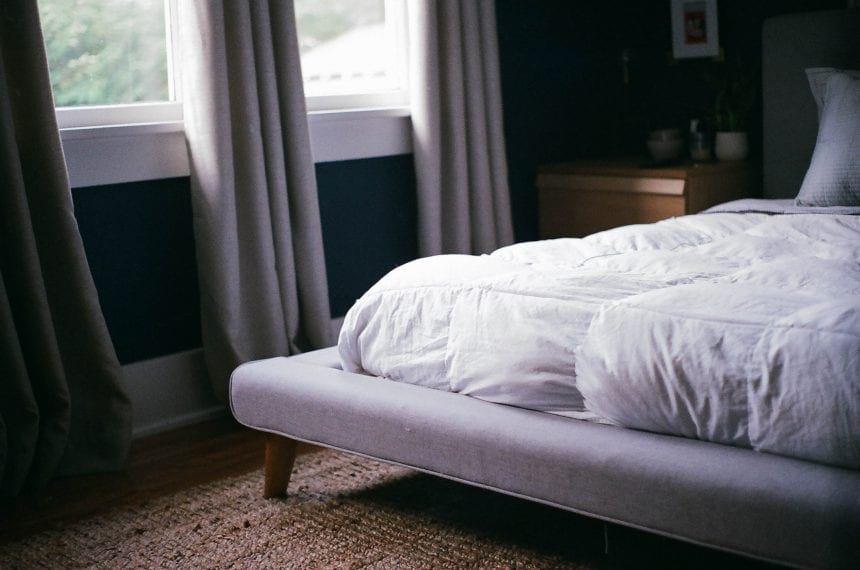We vacuum our floors and mow our lawn, but when is the last time you thought about the cleanliness of your mattress?
On average, a mattress has a lifespan of seven to ten years. During that time, your mattress becomes soiled with bacteria, allergens, dust mites, and bodily fluid.
Dust mites are a tiny bug that are invisible to the bare eye. These pesky creatures are known for feeding on tiny flakes of human skin and producing allergens that we inhale when we sleep. For individuals that are prone to allergies, these little pests might be the trigger. The average used mattress is home to anywhere from 100,000 to 10 million dust mites. Yikes!
Your bed should be a place you are recharged and restored, not a place that makes you sick. For a piece of furniture we spend 27 years of our life on, it’s ironic we take better care of our floors.
1. Wash Your Sheets
Unfortunately, a mattress is a little difficult to deep clean, but there are steps you can take in your daily life to prevent excessive soiling and keep your mattress as fresh as possible, for as long as possible.
This one may seem obvious, but it really is one of the best things you can do Experts recommend washing or changing your sheets every week. Yet, most Americans only change the covers once a month!
When washing your sheets, avoid jamming too many in the washer at once. Not only does overloading the washer machine harm your appliance, but your laundry doesn’t come out as clean. That’s because when a washer is jammed packed it’s harder for the detergent to move around and get the job done. You should also avoid washing your sheets with other items to prevent tangling. As always, wash with similar colors.
As a rule of thumb, make sure to check the label for washing instructions; however, cotton sheets are normally okay on any cycle. Be sure to choose the appropriate soil level of your sheets, but beware that over-washing your sheets can cause them to wear out faster.
While any water temperature will do, it’s recommended you wash your sheets in warmer water during flu season to reduce the amount of allergens.
2. Air It Out
One of the main reasons our mattress is a breeding ground for dust mites and bed bugs is because it is a warm, moist place where these pests thrive. Gross, but true. Not only will keeping your mattress dry help eliminate the threat of bugs, it also helps prevent the growth of mold and mildew.
Stripping your bed helps remove the moisture dust mites need to thrive, causing them to dehydrate and die. Airing out your mattress daily will keep your bed in tip-top shape.
To air out your mattress, you don’t have to do any heavy lifting. Simply pull off all the linens and protectors and let the mattress breathe. Take it one step further and open the blinds of a nearby window to let the sun dry out your mattress even more.
Allow your bed to breathe for at least a couple hours each day before making it.
3. Invest in a Mattress Protector
Another great way to prevent moisture build up is to use a mattress protector. Mattress protectors act as a shield the repels sweat, bodily fluids, and accidental spills. Think of your mattress protector as an extra shield between you and your body. Protectors are also good for preventing the build-up of bacteria which start as our own dead skin cells.
When looking for a mattress protector, you’ll want something that covers 100% of the surface. While some protectors come in the form of a fitted sheet, use an encasement that zips on for optimal protection. If you sleep hot and often wake up with a case of the night sweats, opt for a waterproof protector for an extra layer of protection.
To keep the health of your mattress top notch, find a protector that is machine washable. You won’t want your shield against the imminent bacteria getting soiled.
Other benefits of mattress protectors include helping stabilize your body temperature and prolonging the lifespan of your mattress.
4. Get Out The Vacuum
Another great way to clean your mattress is to run the vacuum over the surface. Although it may sound weird, this is a great way to collect and dust or dead skin cells that might linger otherwise. Doing this every three months will keep your mattress’ hygiene in good standing.
Sleep is integral to our overall health and wellness, and our mattress is the performance tool to getting our best sleep. So we need to make sure we are taking care of it.
No matter how clean we think we are, our mattresses naturally break down and get soiled overtime. If you have noticed a sag developing towards the middle of the bed or you wake up with aches and pains, it may be time to go shopping. Even if you don’t see tangible evidence of degeneration, a mattress over a decade old is most likely not as sanitary as you think.
However, you can use these four tips to help you optimize the lifespan of your mattress.

